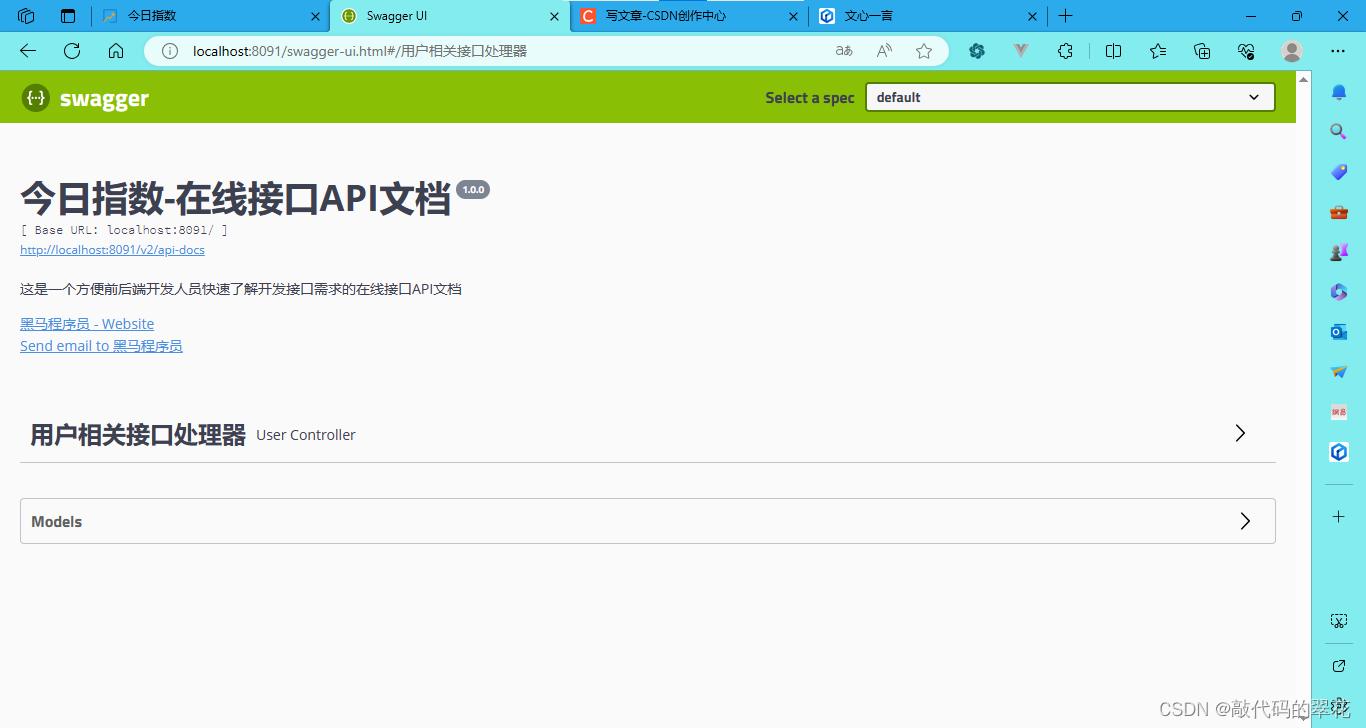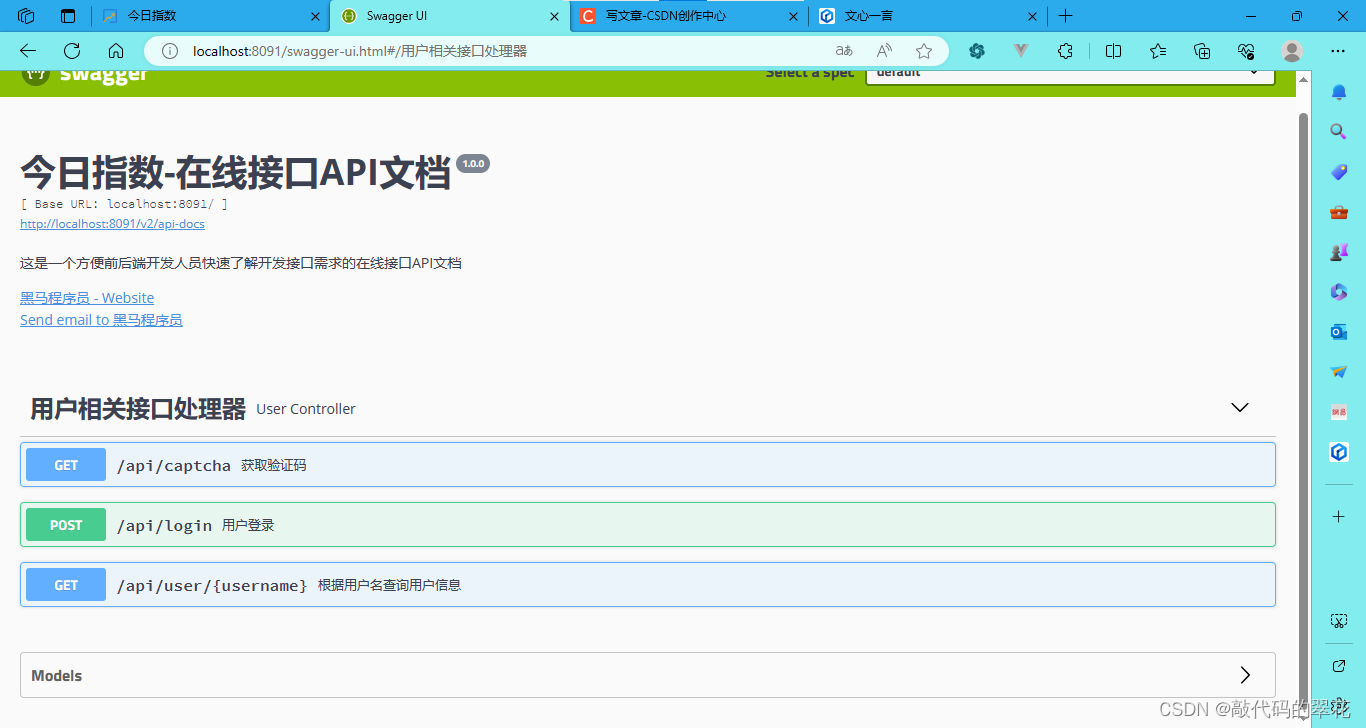07-2-接口文档管理工具-swagger注解使用__ev
发布时间:2024年01月01日
swagger参考demo?
package com.example.swagger2.controller;
import com.example.swagger2.exception.SwaggerException;
import com.example.swagger2.model.User;
import io.swagger.annotations.*;
import org.springframework.web.bind.annotation.*;
import java.util.HashMap;
import java.util.Map;
@Api(tags = "接口服务", value = "/api/v1/swagger/**")
@RestController
@RequestMapping("/api/v1/swagger")
public class ApiController {
@ApiOperation("保存用户信息")
@ApiImplicitParams({
@ApiImplicitParam(name = "name", value = "名字", required = true, paramType = "path"),
@ApiImplicitParam(name = "age", dataType = "int", value = "年龄", required = true, paramType = "query")
})
@PostMapping("/{name}")
@ResponseBody
public Boolean save(
@PathVariable("name") String name,
@RequestParam("age") Integer age
) {
userInfo.put(name, new User(name, age));
return true;
}
@ApiOperation("查询年龄")
@ApiImplicitParams({
@ApiImplicitParam(name = "name", value = "名字", required = true, paramType = "path")
})
@ApiResponses({
@ApiResponse(code = 404, message = "用户不存在", response = SwaggerException.class)
})
@GetMapping("/{name}")
@ResponseBody
public User get(
@PathVariable("name") String name
) throws SwaggerException {
if (!userInfo.containsKey(name)) {
throw new SwaggerException(name + "不存在!");
}
return userInfo.get(name);
}
public static Map<String, User> userInfo = new HashMap<>(16);
}
package com.example.swagger2.model;
import io.swagger.annotations.ApiModel;
import io.swagger.annotations.ApiModelProperty;
import lombok.AllArgsConstructor;
import lombok.Data;
@Data
@AllArgsConstructor
@ApiModel(description = "用户信息")
public class User {
@ApiModelProperty(value = "姓名")
String name;
@ApiModelProperty(value = "年龄")
Integer age;
}
-
swagger相关注解介绍
注解 位置 说明 @Api 类 加载Controller类上,表示对类的说明 @ApiModel 类(通常是实体类) 描述实体类的作用,通常表示接口接收参数的实体对象 @ApiModelProperty 属性 描述实体类的属性,(用对象接收参数时,描述对象的一个字段) @ApiOperation 方法 说明方法的用途、作用 @ApiImplicitParams 方法 表示一组参数说明 @ApiImplicitParam 方法 用在@ApiImplicitParams注解中,指定一个请求参数的各个方面的属性 @ApiParam 方法入参或者方法之上 单个参数的描述信息,描述form表单、url参数 @ApiImplicitParam注解详解:
属性 取值 作用 paramType 查询参数类型 path 以地址的形式(rest风格)提交数据 query 直接跟参数完成自动映射赋值(/add/user?name=zhangsan) body 以流的形式提交 仅支持POST header 参数在request headers 里边提交 form 以form表单的形式提交 仅支持POST dataType 参数的数据类型 只作为标志说明,并没有实际验证 Long String name 接收参数名(方法入参的名称) value 接收参数的意义描述(描述信息) required 参数是否必填 true 必填 false 非必填 defaultValue 默认值
其它注解:
@ApiResponse:HTTP响应其中1个描述
@ApiResponses:HTTP响应整体描述
@ApiIgnore:使用该注解忽略这个API
@ApiError :发生错误返回的信息
把注解应用到项目中
package com.itheima.stock.controller;
import com.itheima.stock.pojo.entity.SysUser;
import com.itheima.stock.service.UserService;
import com.itheima.stock.vo.req.LoginReqVo;
import com.itheima.stock.vo.resp.LoginRespVo;
import com.itheima.stock.vo.resp.R;
import io.swagger.annotations.Api;
import io.swagger.annotations.ApiImplicitParam;
import io.swagger.annotations.ApiOperation;
import org.springframework.beans.factory.annotation.Autowired;
import org.springframework.web.bind.annotation.*;
import java.util.Map;
@Api(tags = "用户相关接口处理器")
@RestController
@RequestMapping("/api")
public class UserController {
@Autowired
private UserService userService;
@ApiOperation(value = "根据用户名查询用户信息")
@ApiImplicitParam(name = "username", value = "用户名", required = true, paramType = "path")
@GetMapping("/user/{username}")
public SysUser findUserInfoByUsername(@PathVariable("username") String username) {
return userService.findUserInfoByUsername(username);
}
@ApiOperation(value = "用户登录")
@PostMapping("/login")
public R<R<LoginRespVo>> login(@RequestBody LoginReqVo loginReqVo) {
return R.ok(userService.login(loginReqVo));
}
@ApiOperation(value = "获取验证码")
@GetMapping("/captcha")
public R<Map> getCaptchaCode() {
return userService.getCaptchaCode();
}
}
?查看效果


文章来源:https://blog.csdn.net/weixin_44478828/article/details/135316518
本文来自互联网用户投稿,该文观点仅代表作者本人,不代表本站立场。本站仅提供信息存储空间服务,不拥有所有权,不承担相关法律责任。 如若内容造成侵权/违法违规/事实不符,请联系我的编程经验分享网邮箱:chenni525@qq.com进行投诉反馈,一经查实,立即删除!
本文来自互联网用户投稿,该文观点仅代表作者本人,不代表本站立场。本站仅提供信息存储空间服务,不拥有所有权,不承担相关法律责任。 如若内容造成侵权/违法违规/事实不符,请联系我的编程经验分享网邮箱:chenni525@qq.com进行投诉反馈,一经查实,立即删除!
最新文章
- Python教程
- 深入理解 MySQL 中的 HAVING 关键字和聚合函数
- Qt之QChar编码(1)
- MyBatis入门基础篇
- 用Python脚本实现FFmpeg批量转换
- netty-daxin-4(http&websocket)
- vue3+echarts 立体柱状效果
- docker部署kafka zookeeper模式集群
- vs c++ qt 打包成exe
- 电脑屏幕横过来了怎么恢复?这4个方法好用又简单!
- FISCO BCOS(十六)多机部署及相关操作
- H5录音效果 html录音 html5麦克风权限
- Angular系列教程之组件
- threejs在透视相机模式下,绘制像素大小固定的元素
- 中国智驾2023的关键词:融资、千元级和BEV算法